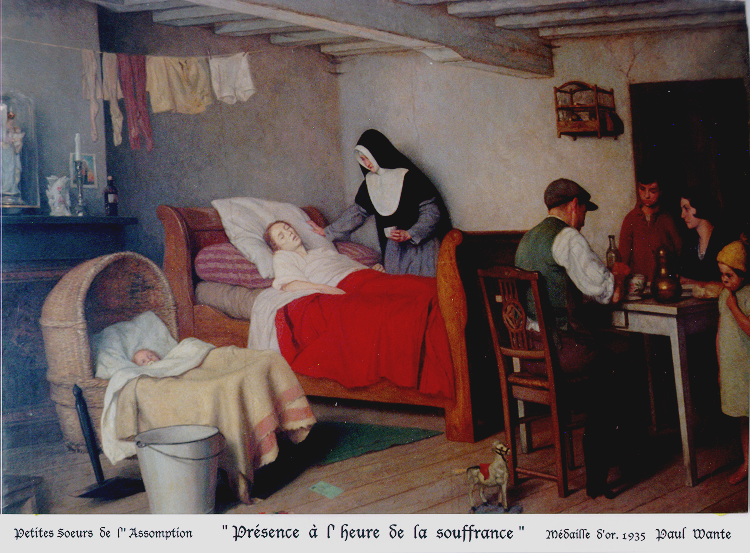Rural exodus and immigration in the second half of the 19th century in France

During the second half of the 19th century, as a result of the industrial revolution, France witnessed the arrival of many immigrants in its cities as well as a significant rural exodus. At the time, while France needed manpower, it was experiencing a major demographic slowdown. Immigration was all the more important as most of the neighbouring countries were experiencing a demographic expansion and as the development of the railway system was beginning to facilitate population movements.
Where did they come from?
The vast majority of immigrants came from neighboring countries: mainly Belgians, followed by Italians, Germans and Swiss, Spaniards, and far behind the English and Luxembourgers.
In the archives of the Little Sisters of the Assumption (LSA), it is the Flemish, Germans, Alsatians and Italians who appear the most often. The sisters had no problem communicating with French speakers (Belgians, Swiss and Luxembourgers). This probably explains why they are not mentioned. The terms “Belgian” and “Flemish” were used interchangeably to refer to the Flemish. “In Creil, […] Sr M. François prepares a Belgian boy, who did not know a word of French, for his First Communion. She also had to act as an interpreter between a sick Belgian woman and the priest“[1]. The LSAs were in contact with Spaniards, especially in Perpignan, near Spain.
The English only appear anecdotally in the archives, as well as Americans and Russians. The sisters also cared for a Guadeloupean.
Jews from Eastern Europe, who were mainly fleeing anti-Semitism and pogroms, are not counted as such because they are of different nationalities. They settled mainly in Paris. They are as poor as the other immigrants. Most of them speak a common language: Yiddish. The Sisters had some contacts with them.
Where would they settle?
Immigration began with seasonal work, mainly Belgians and Italians. They joined the neighbouring regions for a few months and gradually settled there. It was followed by the big urban centers and their outskirts: Paris, Lyon, Marseille, Lille and the industrial region of Lorraine. There was very little immigration in the West. Immigrants and rural exiles often flocked to the same areas by origin to help each other.
And the rural exiles?
At that time, substantial rural exodus prevailed among people from Britany, Auvergne and Provence. They were often regarded as foreigners. Many didn’t speak French or spoke it very poorly.
As for the Alsatians, they had arrived in large numbers after the annexation of Alsace and Moselle by the German Empire in 1871 following France’s defeat. Those who wanted to remain French had to settle in French territory.
Religious practice:
This rural exodus and immigration caused an uproot which weakened religious practice.
There were several factors at play: firstly, many didn’t speak or spoke very little French. Moreover, the isolation and disconnection from their original environment often led to the cessation of their religious
practice. Working on Sundays prevented people from going to mass. They were also often too poor to be able to afford Sunday clothes.
How did the sisters facilitate the religious practice of the exiles?
The LSA did their best to help them revive their religious practice. For instance, they sent them sisters who spoke their language: “Sr M. Aline was sent to a Breton family, that was very surprised and happy to hear a Little Sister speak their language“.[2]
They also asked for help from friends of the congregation such as the Ladies of the Poor[3] who spoke their language or brought priests who knew their language so that they could receive the sacraments, confess, etc.
Father Pernet had previously founded the Fraternity of Our Lady of Salvation[4], an association for the workers that the sisters met when caring for the poor. For the workers who didn’t speak French or who spoke it very little, the LSA had organised meetings on the same model, without the commitment, in the languages of the majority: Breton, Flemish, German and Italian. Once they mastered French, they could then join the Fraternity.
Missions were also organised. The aim was to bring back to religious practice workers who had drifted away from it. The missions were preached by priests mainly in French but other languages could also be used. In Sèvres in particular, there were broad Italian, Breton and German communities: “Sr M. Providence was concerned by the Italians. She would like to organise a mission for them, like that of the Germans. 610 workers, she says, who hardly speak French, are without religious help”.[5]
The LSA also organised retreats to prepare the workers for religious holidays (especially Easter and Christmas). Again, in French or if necessary, in the most commonly spoken languages locally.
In conclusion:
The immigrants of the time do not seem to be perceived as a particular entity. There is no term to refer to them as a whole. The terms “migrants”, “immigrants” are not used nor that of “foreigner”. What seems important is to find people speaking their language to communicate with them, avoid misunderstandings and allow them to practice their religion. They are grouped by language to facilitate religious practice. The idea is not to isolate them but to join them.
Catherine HAMOT
Archive Services March 20
[1] Journal de la Maison Mère (Mother House Journal), Sunday the 19th of November 1882
(2)Journal de la Maison Mère, Saturday the 27th of November 1880.
(3=Ladies Servants of the Poor: It was a group of wealthy laypeople committing themselves to the LSA.
(4)Fraternity of our Lady of Salvation: Association founded in 1881 by Father E. Pernet. The members are workers who commit to living as Christians in their family, neighbourhood and workplace. It then became known as N.D. of the Assumption to avoid confusion with the Salvation Army, especially in England where the Salvation Army was very present.
(5) Journal de la Maison Mère, Monday the 30th of January 1882.
Read the whole article in french
Catherine HAMOT
Service des Archives
Mars 2023
